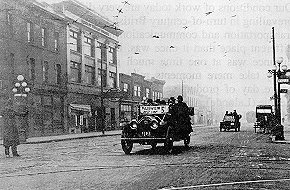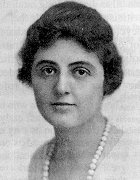| 1 | 2 | 3 | 4 | 5 | 6 | 7 | 8 | 9 | 10 | 11 |
Chapter 1: Indentured Labour
Ferries, Corduroy, and a Jitney
OUR CONDITIONS OF WORK TODAY are very different from those prevailing in turn-of-century British Columbia; advances in transportation and communication make Vancouver a very different place than it once was. In every meaningful way distance was at one time much greater. Legal tasks that today take mere moments might then have occupied an entire day of productive labour. Take the experiences of Leonie (Lalonde) Anderson, for example.
Leonie Lalonde articled in Vancouver in the second decade of the twentieth century and was the first woman to qualify for the British Columbia legal profession entirely within the province. During her qualifying period a strike temporarily closed streetcar service, disrupting commerce and causing considerable inconvenience. Legal work, however, continued:
[O]ne day the firm asked me if I would go to Tsawwassen by way of Ladner, to get a legal document from one of their clients. I said, "Oh, yes, certainly." I thought afterwards, "How do I get there?" and he had hired a jitney to take me, and as far as 16th Avenue the roads were all right, but from 16th Avenue on they were corduroy. That means that the road bed was covered with logs and all the way to the Fraser River on Granville Street I was on this corduroy from Granville to Fraser and then there was a bridge, and then from the other side there was a ferry to Ladner, crossed the island there, and then there was a ferry on the north arm of the Fraser to Ladner. And I was nearly dead by that time. I was shaken over every log. But I got the paper, the processed paper, and had to return the same way. It was terrible. I’ll never forget it. Terrible.

| Jitney on Vancouver's Granville Street, 1915. |
This bone-shaking jitney ride was not undertaken by the young Lalonde in the capacity of a messenger or menial servant—the mission was assigned to her as part of her legal education. She was employed by a law firm under a relationship that in time qualified her to practise law. In common with other aspiring lawyers of the day, the pre-dominant part of her training involved work in a law office: every trainee lawyer was required to spend a full five years in legal apprenticeship. Graduates of "some British or Colonial Universal College duly authorized to confer degrees" were allowed to qualify by only three years of servitude, no special or additional allowance being made for anyone who might happen to have a degree in law. Lawyers, then, trained by working in law offices—usually for little remuneration, occasionally entirely without pay. Low pay and long, tedious days were, apparently, taken in stride. Charles Hamilton explained that in the period immediately following the First World War an "honorarium" of ten dollars per month seemed reasonable to him as he articled in his father’s office:
Of course, in those days, I think it was considered that it was really a privilege to be allowed to learn the trade, as it were, and it was far short of being an apprenticeship, rather than a rendering of services, when you are learning and being taught, and it was a privilege that was given you rather than that you were performing services which you were entitled or expected to be paid for.
Donald Clark Fillmore expressed similar views about his unpaid articles during the Great Depression of the 1930s: "It was a privilege to find someone who had enough space and would take the responsibility of signing you up for articles."
The tasks befalling articling students were set at the whim of their employers, ranging from repetitive administrative procedures and courier service through to fairly advanced legal work. Much depended on the lawyer to whom a student was articled.
Some students found adventurous and perhaps not very educational ways to spend their time in training.
Articles
Law is a practical profession and the historical foundation of professional education is work. For most of its history the legal profession has simply assumed that new lawyers would adequately learn their trade by doing it. Ideally an initial period spent working under the direction of experienced and knowledgeable practitioners would expose the trainee to the mysteries of the lawyer’s art. Over time more or less formal apprenticeships were developed. Lawyers’ guilds came to require service for specified periods of time as what came to be called "articles" developed into the principal mode of qualifying to practise law.
The flavour of professional apprenticeships in British Columbia’s early years is captured in Peter Sibenik’s research on turn-of-the-century legal education in Prairie Canada:
For most of the pre-1921 period, articling was the heart of legal education in the Territories and Alberta. It amounted to a technical training whose efficacy varied from firm to firm. Book learning was something students were expected to pick up in the after-hours. Like their principals, articling students were fonceurs who engaged in part-time time business activities and restlessly roamed the Territories, province and country in pursuit of new economic activities.

| Leonie (Lalonde) Anderson, circa 1920. |
The English legal professions—which provide a profound cultural influence on common-law Canadian lawyers—have in fact long taken great pride in the practical utility of training through apprenticeship. So too, many Canadian lawyers who qualified by articling have thought that much can be said for a system of apprenticeship. Victoria lawyer Robert A. B. Wootton told an interviewer in 1979 that under such a system "you quite clearly, mentally and physically, absorbed your knowledge of the law day by day. We had the advantage of being in the office, seeing and doing what lawyers did and being in court on occasion and having the opportunity to hear some able lawyer address a Judge or to watch the conduct of a case by experts and to see the judge and what his duty was and how he discharged it." Such a system of training, Wootton believed, produced "very able" lawyers who could "practice law with confidence".
While many, many supporters of professional training-by-apprenticeship can be found, criticism of the articling process also has a long and distinguished history. Sustained criticism germinated the seeds from which subsequent developments in legal education grew. Sir George Stephen, for example, was a prominent nineteenth century English solicitor who took great pride in his profession. Nevertheless, he criticized the inadequate education through which the "lower" class of his profession gained their credentials:
They are young men who have probably been introduced in early days, at their early boyhood, at the age of 10 or 12 or 13, as soon as they could write, into an attorney’s office, and employed as copying clerks. They pick up a great deal of practical knowledge, more especially a great deal of familiarity with the peculiar business of their employer; they remain in his office for five or six years, or perhaps seven or eight years, and they become of extreme value to him; and then the attorney, with a view to retain them upon a very moderate salary, and probably with a view of ultimately making them partners, to take off the burthen of his business, will article them; and you may say with respect to a man of that sort, that he is suckled and cradled as an attorney.
To similar effect, English poet, classical scholar, barrister, and university law professor Charles Rann Kennedy critically assessed the training of solicitors as follows: "A young man of sixteen, who has been imperfectly educated, is sent to a solicitor’s office to commence the routine of business, before he knows anything of his subject, and when his mind is not sufficiently formed, to undertake the arduous task of teaching himself on right principles." The outcome was an educational disaster and the Law Magazine commented in 1847 that "A student’s education is a thing of shreds and patches. Their minds are a reflex of marginal notes, and a compendium of points of practice. Rarely do we find radical learning, enlarged powers of generalisation, or a group of principles."
| For my part I challenge that there is no body of men or women of finer intelligence, loftier aims for social improvement, of nicer standards of ethics, of stricter discipline over their membership in everything touching professional conduct, in short of greater individual capacity or a higher code of honor. I further challenge that no other classified body in modern history has proven an equal capacity or labored and accomplished so much for democracy than that of the lawyers; that none are more altruistic, none more qualified, none more sincere and none so indispensable. —M. B. Jackson, Victoria Colonist, June 25, 1922 |
The structures of apprenticeship prevailing at the English Bar (purportedly the more "learned" branch of the divided legal profession) were no better than those of the solicitor’s branch. Odd though it may seem, nineteenth century English barristers qualified principally by dining (yes, eating) in the company of members of the Bar. Lord Campbell succinctly and critically described the system of qualification that had prevailed for the "higher branch" of the English legal profession since the seventeenth century:
All that has been required has been, that the candidate to be called to the Bar should be of fair character; that he should have been a certain number of years upon the books of the Society; that he should have kept a certain number of terms, by eating a certain number of dinners in the Hall each term, and have gone through the form of performing what are still called Exercises, but which consist of a mere farce of a case being stated, and a debate on each side; but the parties being stopped by the time they have read three words of the case, or the argument on either side, the case and the argument being furnished to them by an officer of the Society.
Another distinguished barrister, Lord Brougham, was more dismissive still of what the English Bar called "keeping terms". This amounted, he said, only to "being present at the time grace is said, for a minute or two, a certain number of days in each term".
To be fair, many nineteenth century English "barristers" would have little need for legal knowledge. It was then common for men of "gentlemanly" pretensions to seek Bar membership for reasons of social status rather than career attainment. Of those who did seriously seek to work at the Bar many, most in fact, subjected themselves to some form of apprenticeship to a special pleader, draftsman, or conveyancer. Typically such arrangements were for periods of two or three years. The great nineteenth century reforming barrister, Lord Brougham, was extremely critical of the ad hoc education that resulted:
In attending his master, the pupil is not taught by interposition of the pleader or draftsman; generally speaking he is left entirely to himself; he sees the precedents; he may copy them or not as he chooses; he sees cases brought to be answered by the pleader, or draftsman, or conveyancer; he sees the answers, and he may obtain information by speaking to his master and discussing the subject; but, generally speaking, he is left very much to himself.
All told it is not surprising that an 1846 Select Committee on Legal Education concluded that there was a "total absence of all provision for legal education in the Inns of Court" (the governing bodies of the barristers’ profession), while the solicitors’ branch was, through apprenticeship, taught matters of "mere manual dexterity". There was, they concluded, "no Legal Education, worthy of the name . . . to be had" in England.
Copyright © 1995 The University of British Columbia Faculty of Law. All rights reserved.
Please address questions or comments to Professor W. Wesley Pue, pue@law.ubc.ca